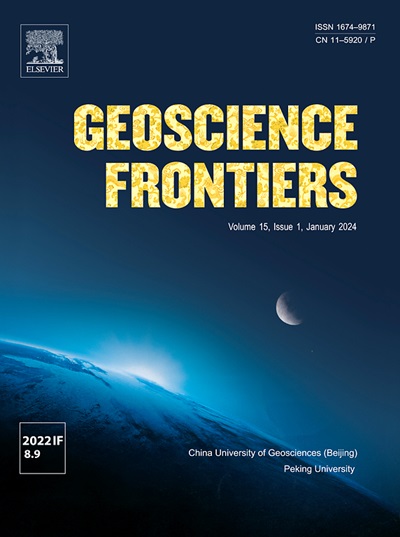An introduction to clay-hosted REE deposits in Australia
IF 8.5
1区 地球科学
Q1 GEOSCIENCES, MULTIDISCIPLINARY
引用次数: 0
Abstract
Rare-earth elements (REEs) are on the critical minerals list in multiple countries due to their application in renewable technologies, electromobility, and defence. A key exploration focus is on clay-hosted REE deposits, which are reported to have a higher proportion of heavy REEs (e.g. Tb and Dy) relative to light REEs. Previous studies have focused on ionic clay-hosted REE deposits in South China and Madagascar; however, little is known about the mineralogy and economic viability of clay-hosted REE projects in Australia. This study provides the first overview of current exploration activities in relation to clay-hosted REE projects in Australia and presents microanalytical data to characterise the distribution of REE-bearing minerals and guide metallurgical processing pathways, as well as mineral system criteria to inform exploration targeting. Our review identified 91 clay-hosted REE projects in Australia, most of which are in the Yilgarn Craton, Albany-Fraser Orogen and the Gawler Craton. Sixteen mineral resource estimates have been completed that have an average grade and tonnage of 971 ppm total rare-earth oxide (TREO) and 145 million tonnes (Mt) across all resources. This study identified monazite, bastnäsite, allanite, zircon, and apatite as the main REE sources in granitic-to-mafic protoliths. These are partially broken-down during weathering resulting in the formation of secondary REE minerals including rhabdophane, bastnäsite, aluminium phosphate sulphate (APS) group minerals, and cerianite. The most significant finding is that the REE budget of Australian clay-hosted REE deposits is dominated by the primary and secondary REE minerals accompanied by a minor ionic proportion. However, some deposits in South Australia, Queensland, and Tasmania yield a higher ionic proportion of >40%. Accordingly, the mineral system model for the majority of Australian projects differs from ionic deposits located in South China due to contrasting exogenic (surface processes) and endogenic (geological) factors, particularly within the Yilgarn Craton, and it remains unclear whether emerging projects within Australia host economic and extractable REEs.

澳大利亚粘土型稀土矿床介绍
稀土元素(ree)由于其在可再生技术、电动汽车和国防方面的应用,在许多国家都被列入了关键矿物清单。一个关键的勘探重点是粘土型稀土矿床,据报道,这些矿床的重稀土(如Tb和Dy)含量高于轻稀土。以往的研究主要集中在中国南部和马达加斯加的离子粘土型稀土矿床;然而,人们对澳大利亚粘土稀土项目的矿物学和经济可行性知之甚少。本研究首次概述了澳大利亚目前与粘土为主的稀土项目相关的勘探活动,并提供了微观分析数据,以表征含稀土矿物的分布,指导冶金加工途径,以及为勘探目标提供信息的矿物系统标准。在澳大利亚共发现91个泥质稀土项目,其中大部分位于Yilgarn克拉通、albony - fraser造山带和Gawler克拉通。已经完成了16项矿产资源估计,所有资源的稀土氧化物(TREO)平均品位和吨位为971 ppm,总稀土氧化物(TREO)为1.45亿吨。花岗岩-基性原岩中稀土元素的主要来源为独居石、bastnäsite、allanite、锆石和磷灰石。这些矿物在风化过程中被部分分解,形成次生稀土矿物,包括横纹石、bastnäsite、磷酸铝硫酸盐(APS)群矿物和铈矿。最重要的发现是澳大利亚粘土型稀土矿床的稀土收支以原生和次生稀土矿物为主,并伴有少量的离子比例。然而,在南澳大利亚、昆士兰和塔斯马尼亚的一些矿床产生更高的离子比例为40%。因此,由于外生(地表过程)和内生(地质)因素的对比,特别是在伊尔甘克拉通内,大多数澳大利亚项目的矿物系统模型与位于华南的离子矿床不同,目前尚不清楚澳大利亚境内的新兴项目是否拥有经济和可提取的稀土。
本文章由计算机程序翻译,如有差异,请以英文原文为准。
求助全文
约1分钟内获得全文
求助全文
来源期刊

Geoscience frontiers
Earth and Planetary Sciences-General Earth and Planetary Sciences
CiteScore
17.80
自引率
3.40%
发文量
147
审稿时长
35 days
期刊介绍:
Geoscience Frontiers (GSF) is the Journal of China University of Geosciences (Beijing) and Peking University. It publishes peer-reviewed research articles and reviews in interdisciplinary fields of Earth and Planetary Sciences. GSF covers various research areas including petrology and geochemistry, lithospheric architecture and mantle dynamics, global tectonics, economic geology and fuel exploration, geophysics, stratigraphy and paleontology, environmental and engineering geology, astrogeology, and the nexus of resources-energy-emissions-climate under Sustainable Development Goals. The journal aims to bridge innovative, provocative, and challenging concepts and models in these fields, providing insights on correlations and evolution.
 求助内容:
求助内容: 应助结果提醒方式:
应助结果提醒方式:


